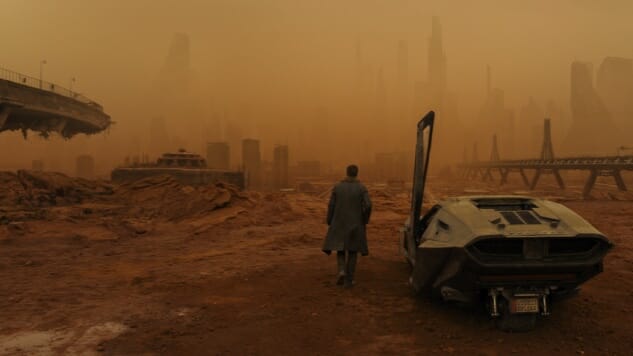
That dystopian movies have become a genre all their own speaks to our fears of the future. As oppressive regimes across the globe turn to technology to control their populaces—and we see our own government putting kids in cages and eroding privacies we’ve long taken for granted—we get a glimpse the terrifying possibilities of where we may be headed. It’s natural for us to explore those what-if scenarios in film, something we’ve been doing since at least 1932 when Fritz Lang brought Metropolis to life.
Not to be confused with post-apocalyptic films (though the two may overlap), dystopian films deal with a decidedly human threat from those in control. Dystopian societies are marked by mass suffering and great injustice, and we don’t always have to look for fiction to see examples. For our purposes here, we’ve focused on Earth, eliminating films where the threat is from another planet. We’ve also eliminated post-apocalyptic films where society hasn’t been rebuilt to the point of a functioning government. That’s left a still very wide swath of cinema to consider, from sci-fi looks into the distant future to cautionary tales of a much more recognizable world in our present or even past. This may not be escapism, but as the increasing number of dystopian movies, novels and TV series prove, we remain captivated by stories of societies gone wrong and the struggle of individuals to overcome.
Here are the 50 best dystopian movies of all time:
50. The Running Man (1987)
Director: Paul Michael Glaser
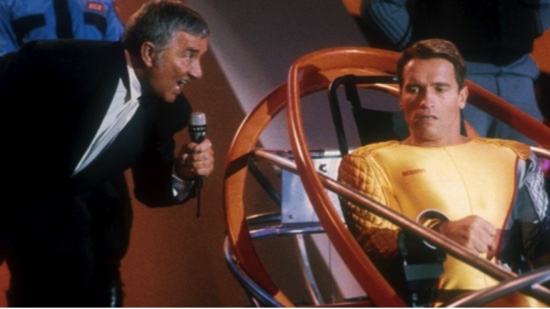
While The Running Man lacks the sophistication and dynamic pacing of a certain other Schwarzenegger-starring/dystopian sci-fi/satire film, its entertainment value is nothing to sneer at. Adapted loosely from a Stephen King novel of the same name, The Running Man depicts a future where everyone dresses like they’re at an ’80s-themed Halloween party and citizens regularly tune into a show where convicted criminals must fight to survive against both their fellow contestants and professional killers. Insert Hunger Games reference here. Between the absurd production design and Paula Abdul-choreographed dance sequences, any attempted satire is all but buried in a thick layer of silly. Still, in terms of sheer fun value, this film is quite the gem. —Mark Rozeman
49. Alita: Battle Angel (2019)
Director: Robert Rodriguez
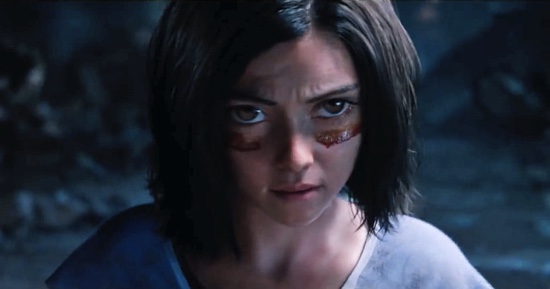
Alita: Battle Angel begins with Dyson Ito (Christoph Waltz), doctor to cyborgs, scavenging through a junkyard full of spare parts in order to find anything he can use. What better way to start a film than with a metaphor about itself? Just like Dr. Ito, director Robert Rodriguez and co-writer/co-producer James Cameron sift through the remnants of established sci-fi and cyberpunk properties in order to glue together a recognizable and cohesive narrative within the confines of its genre. Considering the talent involved, it’s not surprising that the finished product is a frequently fun and kinetic, visually pleasing sci-fi/actioner, albeit one that doesn’t have a single new or fresh part embedded in it. Based on the popular manga, Gunnm, Alita: Battle Angel mostly takes its visual cues and narrative structure from a 1993 anime adaptation by the same name. That anime is barely an hour long, yet manages to pack in a sprawling cyberpunk universe with a deep and complex lore that supports whatever over-the-top tech fetish cyber action it throws at you. The story follows Alita (Rosa Salazar), whom Dr. Ito finds during his junk hunt and brings back to life. Her brain is human, but the rest of her is artificial. Just like a cyborg version of Jason Bourne, she doesn’t remember her past, but has supreme ass-kicking instincts, leading Ito to suspect some sinister military use in her past. The future world that Battle Angel inhabits is the lovechild of Blade Runner and Mad Max, a grimy post-apocalyptic city that’s also a grand, overpopulated cyberpunk metropolis. When the fighting finally begins, Battle Angel gets its metallic ass in gear. Rodriguez pushes the confines of the PG-13 rating to create some genre- and source-material-appropriate hack-and-slash gruesomeness with a significant amount of cyborg bodies split in half, decapitated and torn to pieces. For fans of futuristic sci-fi/action, it should provide an engaging if somewhat forgettable experience. —Oktay Ege Kozak
48. Never Let Me Go (2010)
Director: Mark Romanek
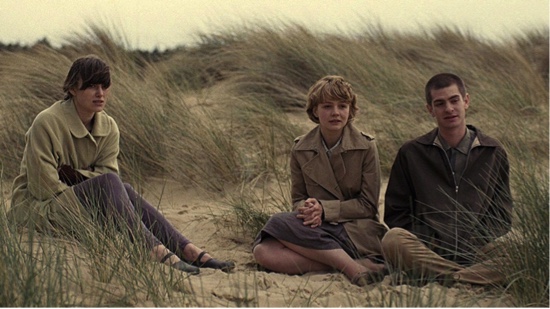
An adaptation of a novel by Kazuo Ishiguro, Never Let Me Go is just as poignant and melancholy, centering on a group of young people who grow up with a seemingly carefree life in an English boarding school. The beautiful pastoral setting hides the disturbing truth that Kathy (Carey Mulligan), Tommy (Andrew Garfield), Ruth (Keira Knightley) and their classmates are clones, fated to be compulsory organ donors for their rich counterparts when they grow up. Confronted with this grim and unavoidable future, characters are faced with urgent questions about love, relationships, family and death. Pensive about matters of life and death, about what makes life worth living, Never Let Me Go features dark reminders of death’s inevitability while offering hope in the opportunity to reflect on what we should hold closest in whatever time we have left. —Kara Landhuis
47. Idiocracy (2006)
Director: Mike Judge

Idiocracy’s dystopian setting is based on the idea of runaway “dysgenics,” the opposite of selective breeding: the inverse of natural selection, once the intelligent segment of the population gets “outbred” by the stupid. It’s an interesting idea to drop on Everyman Joe Bauers (Luke Wilson), who arrives as a time traveler from 500 years earlier only to have himself proclaimed as the smartest man in creation. The average person in this setting, though, is facing a rather featureless, bland and frankly obnoxious day-to-day life, with a crippled economy, food shortages and poor mental and physical health. The upside? They’re mostly too stupid to notice or care theirs is an existence of boring, mushy pablum. —Jim Vorel
46. Punishment Park (1971)
Director: Peter Watkins
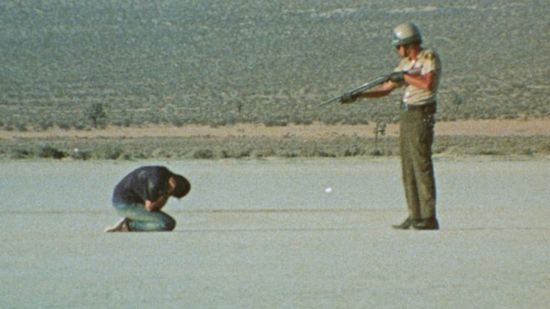
Pseudo-documentary-style surveyor of both past and future Peter Watkins’ Punishment Park is willfully confrontational—it’s why Hollywood studios refused to distribute the film on release. (It played at one New York cinema for four days before it was pulled.) In the California desert, a group of young activists are given an option: Go to jail, or go to Punishment Park, and run to the American flag planted 50 miles away over scorching sands before the police catch you first. Most everyone chooses the park, where trigger-happy cops and soldiers lie in wait. Punishment Park is critical both of the regime oh-so-close to the real one of 1971, and of the activists turning to violence as a means to bring peace. This isn’t an easy watch, primarily because what makes the activists angry—police brutality, inequality, bureaucratic injustice, pointless wars—are still making people angry today, 44 years down the line. The real world’s inability to learn and move on is keeping Watkins’ film relevant. —Brogan Morris
45. Snowpiercer (2014)
Director: Bong Joon-ho
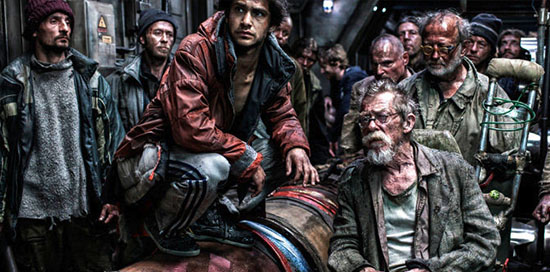
There is a sequence midway through Snowpiercer that perfectly articulates what makes Korean writer/director Bong Joon-ho among the most dynamic filmmakers currently working. Two armies engage in a no-holds-barred, slow motion-heavy action set piece. Metal clashes against metal, and characters slash through their opponents as if their bodies were made of butter. It’s gory, imaginative, horrifying, beautiful, visceral and utterly glorious. Adapted from a French graphic novel by Jacques Lob, Benjamin Legrand and Jean-Marc Rochette, Snowpiercer is a sci-fi thriller set in a futuristic world: Nearly two decades prior, in an ill-advised attempt to halt global warning, the government inundated the atmosphere with an experimental chemical that left our planet a barren, ice-covered wasteland. Now, the last of humanity resides on “Snowpiercer,” a vast train powered via a perpetual-motion engine and governed by a ruthless caste system. Needless to say, this scenario hasn’t exactly brought out the best of humanity. Bong’s bleak and brutal film may very well be playing a song that we’ve all heard before, but he does it with such gusto and dexterous skill you can’t help but be caught up the flurry. —Mark Rozeman
44. Alphaville (1965)
Director: Jean-Luc Godard
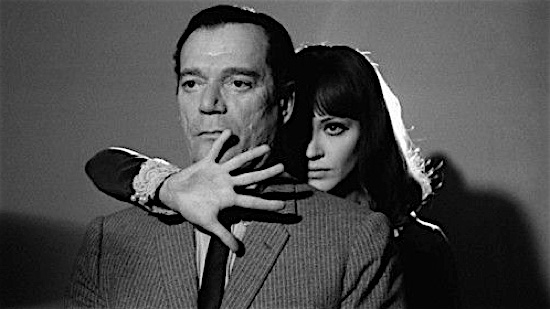
Science-fiction isn’t particularly suited to Godard’s gaze—so erratic and tongue-in-cheek, so uninterested in the exigencies and peculiarities of world-building is the legendary French director—but there is also no better visionary to attack the mind-fuck that is this weirdo Lemmy Caution adventure. Alphaville is as much an experimental noir as it is speculative fiction, steeped in the tropes of the former while blissfully tinkering with the world of the latter, never quite justifying the hybridizing of both but never quite caring, either. As such, the pulpy story of a secret agent (Eddie Constantine) who’s sent into the “galaxy” of Alphaville to assassinate, amongst a few, the creator of the artificial intelligence (Alpha 60) which runs all facets of Alphavillian society by pretty much outlawing all emotion—meanwhile falling in love with the daughter of the inventor (Godard muse Anna Karina)—is as goofy as it is compelling, fully committed to the confusing premise and aware, as most Godard films are, of the leaps required of the audience to follow the meandering plot. Saturated with anachronism and stylized to the point of parody, Alphaville isn’t interested in immersing a viewer in a not-so-distant dystopian future as it is in laying bare science fiction as a genre which demands we dramatically re-conceptualize everything about the genre we take for granted: language, humanity and a future we’ll at least kind of understand. —Dom Sinacola
43. Equilibrium (2002)
Director: Kurt Wimmer

In Equilibrium, Taye Diggs plays a future fascist law enforcement officer named Brandt, and near the climax of the film, Brandt gets his face cut off. That’s his whole face, impeccably separated from his head, hair- to jawline. This follows a kind of lightning-quick, future samurai sword fight in which Christian Bale’s character, the heroically named John Preston, has singlehandedly massacred his way, gun in one hand and sword in the other, through one law enforcement officer after another, determined to wrench humanity from the binds of a totalitarian state that has outlawed—you guessed it—feelings. Much like Taye Diggs’ face, Equilibrium is quite pretty in its action, very symmetrical. But also like his face, the fact that I just gave away a meaty part of the climax should be easily disconnected from whether or not you should still watch Equilibrium. You should: it’s all as simultaneously bonkers and well-mannered as the moment in which Taye Diggs’ face slides off the front of his head like salami from a meat slicer. —Dom Sinacola
42. Sleeper (1973)
Director: Woody Allen
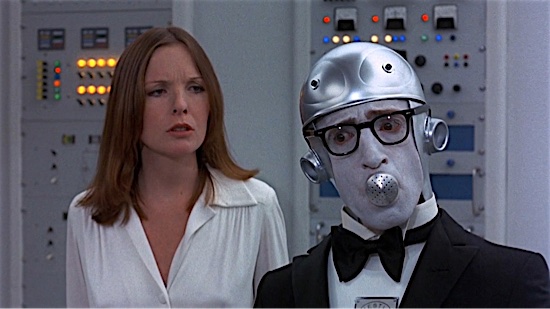
Sleeper’s sci-fi slapstick is Woody Allen comedy at the peak of the legendary filmmaker’s powers. Miles Monroe (Allen), as a cryogenically unfrozen man out of time, is drafted into an underground resistance movement against a tyrannical, robot-enforced police state. (In today’s political climate, its prescience feels eerie, if obvious.) What follows is pinpoint physical comedy, hilariously Allen-esque one-liners and some side-splittingly funny sight gags (not to mention the incomparably talented Diane Keaton) pervading the future dystopian America of 2173. Thankfully, for Miles, the police state of the future is evidently more incompetent than him. Would that we were so lucky today. —Scott Wold
41. Moon (2009)
Director: Duncan Jones
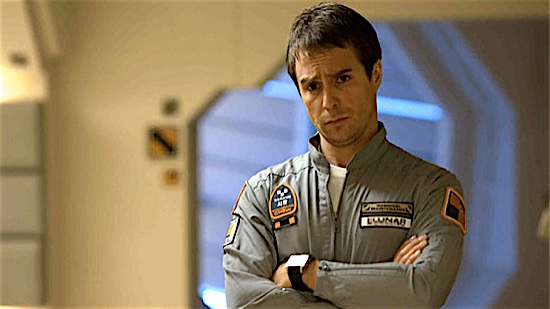
First-time director Duncan Jones is overt about his stylistic appropriations of Stanley Kubrick’s 2001: A Space Odyssey, right down to the sweeping orchestral music that frames the opening shots of the titular satellite and Earth. Yet, where Kubrick tapped into existential fears about human extinction and the future of civilization, Jones hypothesizes the logical conclusion of that dark vision: a world where the need for more energy has rendered humanity a manufactured cog of multinational corporations whose reach now extends beyond the boundaries of Earth. The film’s plot centers on Sam Bell (Sam Rockwell), the only human on a lunar mining facility that harvests Helium-3, a clean fuel that can meet a near-future Earth’s ballooning energy demands. Base computer system GERTY (Kevin Spacey) is his sole companion on Sam’s three-year caretaking mission, since a supposed satellite failure means he can only send and receive pre-recorded messages. When an accident nearly kills Sam, he’s saved by a clone of himself and begins to unravel the sinister nature of the base, and his existence. Moon cribs heavily from the retro-futuristic look of ‘60s and ‘70s sci-fi for its claustrophobic and sanitized depiction of the moon base, but this high-tech eye candy is only the backdrop to a larger morality tale about humanity’s ever-shrinking position within a technologically-saturated society. When the human experience can be synthesized (and thus made disposable), does such a thing as “humanity” even exist? There’s a host of challenging philosophical threads throughout—cloning, masculinity, energy, corporate power—but those individual issues complement rather than engulf the larger narrative. Moon is a superlative example of science fiction that hearkens to the genre’s roots: social commentary on the human condition, without the easy catharsis of overblown special effects and space opera. It’s the ultimate rarity in modern cinema: a mature, engaging and thoughtful sci-fi movie, and proof that there’s life yet left in the genre. —Michael Saba
40. Escape From New York (1981)
Director: John Carpenter
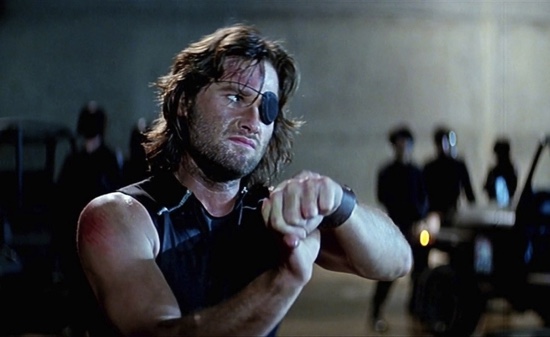
In the far future of 1997, when the president’s Air Force One flight is hijacked and crash-lands in the now-maximum security prison of Manhattan, there’s only one man who can save him, a one-eyed Kurt Russell who goes by the name of Snake. He struggles to thwart The Duke’s plans to use the President as a human shield in his march to freedom, all while maintaining his badass disdain for the US government. Written in the wake of the Watergate scandal, John Carpenter’s view of the future is a decidedly cynical one: Snake may be trying to save the president, but not without his classic sneer. —Sean Doyle
39. Silent Running (1971)
Director: Douglas Trumbull
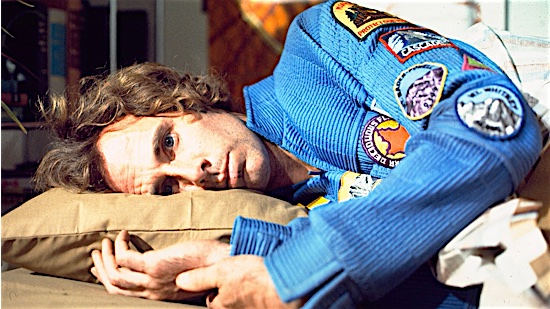
A precursor to both Wall-E and Moon, Silent Running was the first feature directed by Douglas Trumbull, the special-effects wizard best known for his work on 2001: A Space Odyssey, Close Encounters of the Third Kind and The Tree of Life. Set on a spaceship hovering around Saturn, this meditative film concerns an interstellar greenhouse custodian named Freeman Lowell (Bruce Dern) who’s keeping watch over the last of Earth’s forests and wildlife. When Lowell is told to destroy his payload and return to Earth, he refuses, deciding instead to fake an accident and pilot his ship into the farthest reaches of space, where he and his living wards will be safe from human interference. Ecologically conscious, narratively simple, deeply affecting, Silent Running is one of those great lost gems of 1970s sci-fi. —Tim Grierson
38. Strange Days (1995)
Director: Kathryn Bigelow
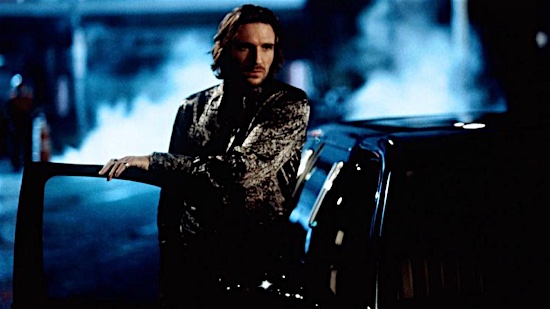
Before she reinvented herself as the director of award-winning docudramas, Kathryn Bigelow made her name directing crazy genre movies like Near Dark and Point Break. With all respect to Point Break, however, Strange Days remains Bigelow’s most compelling pre-War on Terror project. Written by Bigelow’s former husband James Cameron and Oscar-nominated screenwriter Jay Cocks, Strange Days is a pulpy, noir-influenced sci-fi pic in the vein of Blade Runner but with more high-octane action and a lot more nudity. Developed in the era of the videotaped Rodney King beatings and the L.A. riots, the film is set in a dystopian Los Angeles where people’s memories and experiences are recorded directly from their brains to sell on the black market. Anyone who has ever wanted to experience criminal activities or perverse sexual encounters can now do so without repercussions. The trouble begins when vice-detective-turned-black-marketer Lenny Nero (Ralph Fiennes) discovers a “snuff” disc depicting the brutal murder of an acquaintance. This disc leads him down a rabbit hole into the urban underground. At nearly two and a half hours, the film’s visual pyrotechnics and beautifully stylized performances provide more than enough ammunition to justify such excess. —Mark Rozeman
37. Dark City (1998)
Director: Alex Proyas

Alex Proyas’s magnum opus serves up a cerebral sci-fi extravaganza as filtered through the visual tropes of film noir and German Expressionism. A staggering achievement in imagination, Dark City, like clear predecessor Blade Runner, flopped at the box office only to be revived later as a beloved cult classic. The film casts Rufus Sewell as amnesiac John Murdoch who wakes up one night to discover that his city is (quite literally) under the manipulation of a band of mysteriously pale men in jet-black trench coats and fedoras. Along for the ride is Kiefer Sutherland as a crazed scientist and Jennifer Connelly as the femme fatale, our hero’s estranged wife. One might also draw a straight line between this and The Matrix, released a year later. The similarities between the two films’ visual styles and themes of slavery, techno-rebellion and free will are nigh-impossible to miss, and many visual essays have been written specifically to compare the two movies. John Murdoch’s arc is only slightly less portentous than that of the prophesied One (Keanu Reeves) in The Matrix—both are seemingly normal men scooped up and thrust into a web of slowly untangling secrets while discovering that they possess special powers that will eventually allow them to defeat the puppetmasters who created their reality. The two films were even largely filmed at the same studio—Fox Studios Australia—and possess a similar green-tinged patina of unreality. Ultimately, Dark City is a bit more philosophically aloof than the popcorn-munching, easier to grasp Matrix, which is probably the reason the latter eventually became a cultural touchstone. But Dark City deserves to be seen, both on its own merits and as an exercise to see which of its sights may have lodged in the mind of the Wachowskis, waiting to be reborn in the next year’s blockbuster. —Mark Rozeman and Jim Vorel
36. A.I. Artificial Intelligence (2001)
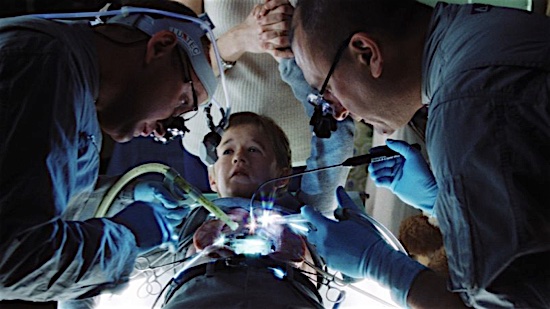
A.I. may be Spielberg’s misunderstood masterpiece, evidenced by the many critics who’ve pointed out its supposed flaws only to come around to a new understanding of its greatness—chief among them Roger Ebert, who eventually included it as one of his Great Movies ten years after giving it a lukewarm first review. A.I. represents the perfect melding of Spielberg and Stanley Kubrick’s sensibilities—as Kubrick supposedly worked on the story with Spielberg, and Spielberg felt obliged to finish after Kubrick’s death—which allows the film to keep each of their worst instincts in check. It’s not as cold or distant as Kubrick’s films tend to be, but not as maudlin and manipulative as Spielberg’s films can become—and before the ending is brought out as proof of Spielberg’s failure, it should be noted that the film’s dark coda was actually Kubrick’s idea, adamant that the ending not be meddled with moreso than any other scene. A closer inspection of the film’s themes reveal a much bleaker conclusion—and, no, those aren’t “aliens.” —Oktay Ege Kozak
35. Isle of Dogs
Director: Wes Anderson
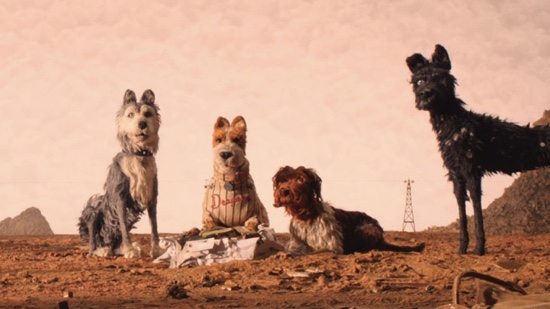
Isle of Dogs may be the closest Wes Anderson will ever get to a sci-fi film. Of course he would use stop-motion animation to make it. Set 20 years from now, amidst the ultra-urban monoliths of Megasaki City—a Japanese metropolis that also seems to be Japan, or at least a Westernized idea of the small island nation—the film begins care of a decree by Mayor Kobayashi (Kunichi Nomura), a boulder of a man with equal ties to an ancient lineage of cat-loving aristocrats and to, based on the elaborate back tattoo we glimpse atop his tight little butt in a quick bath scene, an archetype of organized crime and political corruption. Due to a vaguely described epidemic of “dog flu” (or “snout fever”), Kobayashi bans all dogs to Trash Island, a massive byproduct of technology and futurism, beginning with Spots (Liev Schreiber), the guard dog of 12-year-old Atari (Koyu Rankin), who also happens to be the Mayor’s ward after Atari’s parents died in a horrible accident. Since Bottle Rocket in 1996, the more manicured Anderson’s films have become—his obsessive control over his frames broadening into grander and grander worlds—the more we may be apt to extol his accomplishments rather than get invested in his stories. And it’s probably never been easier to do that than with Isle of Dogs, so rife with meticulousness and imagination, as is Anderson’s brand, and so unconcerned with steering this ostensible children’s movie towards actual children. For a director who pretty much defined a generation’s cinematic fetishization for symmetry (and quirky hipster nonsense) to then fetishize a country to which Westerners mainly relate through fetishization? So much of this beautiful movie just sort of eats itself. Still, the emotional weight of Isle of Dogs depends on knowing exactly what that bond between dog and human can mean, how deeply and irrationally it can go. At the core of Isle of Dogs is that kind of best-friendship: No matter how far we advance as a civilization, how disastrously we atomize and digitalize our lives, we’ll always have the devoted dependence of a dog, our immutable companion across the vast wasteland of human history. —Dom Sinacola
34. Ghost in the Shell (1995)
Director: Mamoru Oshii
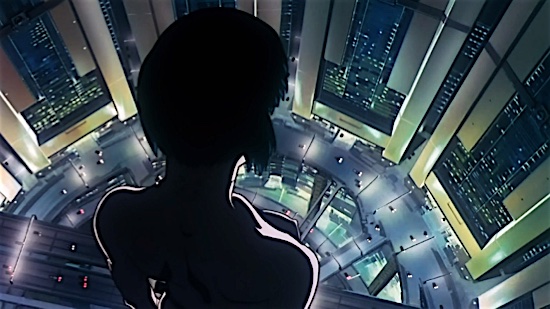
It’s difficult to overstate how enormous of an influence Ghost in the Shell exerts over not only the cultural and aesthetic evolution of Japanese animation, but over the shape of science-fiction cinema as a whole in the 21st century. Adapted from Masamune Shirow’s original 1989 manga, the film is set in the mid-21st century, a world populated by cyborgs in artificial prosthetic bodies, in the fictional Japanese metropolis of Niihama. Ghost in the Shell follows the story of Major Motoko Kusanagi, the commander of a domestic special ops task-force known as Public Security Section 9, who begins to question the nature of her own humanity surrounded by a world of artificiality. When Motoko and her team are assigned to apprehend the mysterious Puppet Master, an elusive hacker thought to be one of the most dangerous criminals on the planet, they are set chasing after a series of crimes perpetrated by the Puppet Master’s unwitting pawns before the seemingly unrelated events coalesce into a pattern that circles back to one person: the Major herself. Everything about Ghost in the Shell shouts polish and depth, from the ramshackle markets and claustrophobic corridors inspired by the likeness of Kowloon Walled City, to the sound design, evident from Kenji Kawai’s sorrowful score, to the sheer concussive punch of every bullet firing across the screen. Oshii took Shirow’s source material and arguably surpassed it, transforming an already heady science-fiction action drama into a proto-Kurzweil-ian fable about the dawn of machine intelligence. Ghost in the Shell is more than a cornerstone of cyberpunk fiction, it’s a story about what it means to craft one’s self in the digital age, a time where the concept of truth feels as mercurial as the net is vast and infinite. —Toussaint Egan
33. District 9 (2009)
Director: Neill Blomkamp

Let’s begin with a number: 30 million. That’s how much money Neill Blomkamp spent to make District 9, a movie small in scale but great in ambition, look like it cost four times that amount. Years later, Blomkamp’s career hasn’t realized the full promise shown in District 9, but here, he looks like a guy knows what he’s doing all the same. A genre stew blended from varying measurements of Alien Nation, Watermelon Man, Independence Day, The Fly and RoboCop, District 9 treads familiar territory in an unfamiliar place, through an unfamiliar lens, splicing documentary-style filmmaking together with stomach-churning body horror and, by the end, high-end action spectacle. At the time, the end results of Blomkamp’s mad sci-fi cocktail felt revelatory. Today they feel disappointing, a remark on what he could have been and where his career might have taken him if he’d not lost himself in the morass of Elysium or turned off even his more devoted followers with Chappie. All the same, District 9 remains a major work for a first-timer, or even a third-timer, polished and yet scrappy at the same time; the film tells of an artist with something to say, and saying it with electric urgency. —Andy Crump
32. The Truman Show (1998)
Director: Peter Weir

Peter Weir’s delightful, hilarious The Truman Show wouldn’t get made anymore. It’s a star-studded event film centered around a simple and dystopian premise: Jim Carrey’s eponymous character has unwittingly been raised from birth as a reality TV star and only now has begun to suspect that everybody in his life is a hired actor. Carrey’s clear-eyed acting is worlds away from the zany roles that catapulted him to fame a few short years prior, though, as was typically the case with Carrey roles in the ’90s, copious amounts of special effects work go toward creating a believable simulated reality for Carrey’s endearing everyman to be trapped within. The heartfelt monologues and devastating revelations as he fights to escape his gilded cage shine all the brighter for it. The fight to break away from control, from a sanitized and curated existence dictated by a literal white father figure in the sky, rings alarmingly two decades years later, when social media has made performative brand managers of us all. Truman is an unlikely and often hapless hero in his own story, but his eventual hijacking of his own narrative—and his final defiance of his literal and figurative creator figure—form one of the most heroic cinematic arcs of the last 20 years. —Kenneth Lowe
31. Dredd (2012)
Director: Pete Travis

Seventeen years was probably far too long after the fact to offer an apology to comic book fans for 1995’s abominable film adaptation of Judge Dredd. After that extended leave of absence, no one could blame American audiences for having long since stopped wondering why the hell John Wagner and Carlos Ezquerra’s grim lawman endured as one of Britain’s most popular comic book anti-heroes. Still, 2012’s Dredd 3D wastes no time showing why—director Pete Travis’s film is a brutally efficient exercise in B-movie know-how. Karl Urban, who’s no stranger to tightly wound sci-fi fare, provides the scowl and chin of Judge Joseph Dredd, a total-law package professional who is clearly as disinterested in humoring his rookie partner (Olivia Thirlby) as the script is in coddling its audience. A few lines of raspy Man with No Name narration, coupled with a superbly bleak establishing shot from cinematographer Anthony Dod Mantle, are all the generosity afforded by the filmmakers toward understanding this world before it unleashes chase sequences and bursting heads. This is a film that respects its source’s established fan base, and cares little for casualties who can’t hang on through its grindhouse paces. Apology accepted. —Scott Wold
30. Okja (2017)
Director: Bong Joon-ho

Okja takes more creative risks in its first five minutes than most films take over their entire span, and it doesn’t let up from there. It’s perhaps the finest example yet of the wild pendulum swing of a Bong film’s rhythmic tonality—the culmination of Bong’s unique rhythms into something like a syncopated symphony. The film opens with Tilda Swinton’s corporate maven Lucy Mirando leering out an expository dump of public relations about her new genetically created super-pigs, which will revolutionize the food industry. We’re also introduced to Johnny Wilcox, played by Gyllenhaal as a bundle of wretched tics, like there’s a tightly-wound anime character just waiting to rid itself of its Gyllenhaal flesh, but in the meantime barely contained. Okja is the finest of the super-pigs, raised by a Korean farmer (Byun Hee-bong) and his granddaughter Mija (Ahn Seo-hyun), an orphan. Okja is Mija’s best friend, a crucial part of her family. Bong takes his sweet time with this idyllic life Mija and Okja share. The narrative slows down to observe what feels like a Miyazaki fantasy come to life. Mija whispers in Okja’s ear, and we’re left to wonder what she could possibly be saying. The grandfather has been lying to Mija, telling her he has saved money to buy Okja from the Mirando corporation. There is no buying this pig; it is to be a promotional star for the enterprise. When Johnny Wilcox comes to claim Okja (a sharp note of dissonance in the peaceful surroundings) the grandfather makes up an excuse for Mija to come with him to her parents’ grave. It is there he tells her the truth. Mija’s quest to rescue Okja brings her in alliance with non-violent animal rights activists ALF, which ushers the film into a high-wire act of an adventure where Bong’s penchant for artful set-piece is pushed to new heights. The director works with an ace crew frontlined by one of our greatest living cinematographers, Darius Khondji, who composes every frame of Okja with vibrant virtuosity. The very action of the film becomes action that is concerned with its own ethics. As the caricatures of certain characters loom larger, and the scope of the film stretches more and more into the borderline surreal, one realizes that the Okja is a modern, moral fable. It’s not a film about veganism, but it is a film that asks how we can find integrity and, above all, how we can act humanely towards other creatures, humans included. The answers Okja reaches are simple and vital, and without really speaking them it helps you hear those answers for yourself because it has asked all the right questions, and it has asked them in a way that is intensely engaging. —Chad Betz
29. Gattaca (1997)
Director: Andrew Niccol
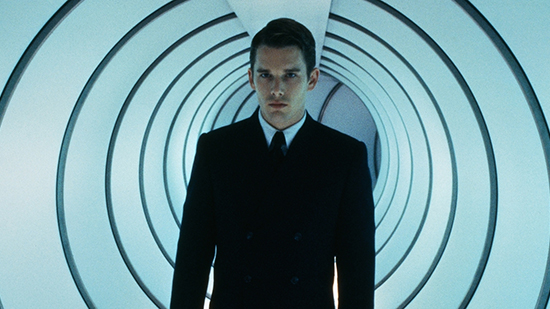
Less given to gadgetry and special effects than deeply felt characters, Andrew Niccol’s 1997 film envision a near-future in which almost all children are lab-created and genetically modified to prevent any mental or physical “imperfections.” Ethan Hawke stars as Vincent, a “God child” conceived naturally and therefore irrevocably flawed. In order to pursue his ambitious career dreams, Vincent seeks help from a DNA broker and assumes a new, genetically superior identity. Archetypal in construction, the film uses a beautiful orchestral score by veteran composer Michael Nyman (The Piano) to evoke an atmosphere that both melancholic and reflective, layered over impeccable production design. The film’s every visual element, from color saturation to sound design, assists in immersing viewers in an atmosphere, like those beings one semantic step from being synthetic, simultaneously familiar and completely alien. —Kara Landhuis
28. THX 1138 (1971)
Director: George Lucas
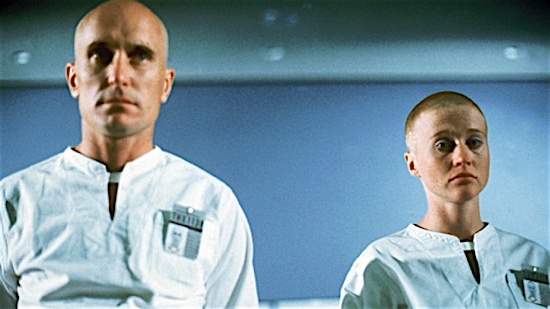
The brilliance behind George Lucas’s choice to have his dystopic society disciplined via android cops is that there’s little difference between the machines who keep the “peace” and the people for whom they’re keeping it. Resembling a sort of campy take on highway patrolmen (think the Village People, except with way less singing) spliced with G.I. Joe’s Destro, the robot police force is governed solely on “budget,” which of course allows our hero THX (Robert Duvall) to escape the underground society, and the mysterious deity, OMM 0910, that represses him. Yet, in being left to his own devices after OMM determines that chasing after THX would put the robot police force 6% “over budget,” even THX’s humanity is further reduced to a matter of balancing numbers. It may be a point of triumph for our protagonist, but in perhaps the most subtle thematic move the director has ever made, Lucas is implying that even the organic characters in THX 1138 are mere tools for a higher power. —Dom Sinacola
27. A Scanner Darkly
Director: Richard Linklater

A Scanner Darkly, Richard Linklater’s second animated-over-live-footage film, can be hard to remember without recalling specific circumstance. It hits that deeply, touches that kind of nerve—looks the way everything feels when pumped full of anesthesia for surgery, nothing in any frame still, everything crawling like hallucinated bugs in the film’s opening scene. About a future in which the War on Drugs is lost and a new drug named Substance D is sweeping the nation, A Scanner Darkly adapts the Philip K. Dick novel to follow Bob Arctor (Keanu Reeves) as an undercover detective who becomes an addict, the drug splitting his personality into two. Arctor takes D with his friends James Barris (Robert Downey, Jr.) and Ernie Luckman (Woody Harrelson), and things have gotten bad. Those bugs? They’re not real, but they’re crawling all over him at any given moment. Accordingly, RDJ and Harrelson are not actors who deal in stillness, constantly moving, always some nervous twitch displaying some desperate itch that begs to be scratched. Toss in animation that dances from frame to frame, and we’re a long way from the gorgeous Vienna of Before Sunrise or the suburban high school of Dazed and Confused. Still, Linklater masterfully guides each scene to maintain the sense of dread permeating Dick’s dystopian work. —Travis M. Andrews
26. Logan’s Run (1976)
Director: Michael Anderson
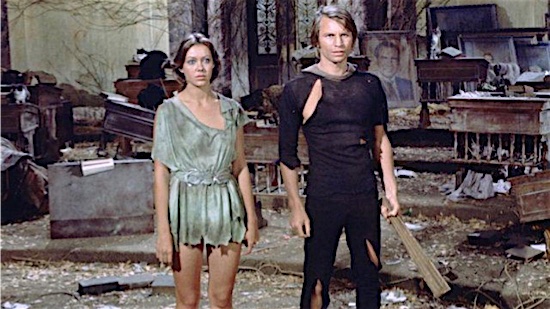
In the far-flung future of 2274, 30 is the new 80. Unfortunately for those who think they’re entitled to a second act in life, like Logan 5 (Michael York), escaping can get you sentenced to “Deep Sleep” by the Gestapo-like Sandmen. And even if you make it past the human assassins, you could still wind up face-to-chrome grill with Box, the magnificently melodramatic robot who ran out of fish! And plankton! And sea greens! And protein from the sea!, and so decided it might as well flash-freeze some fresh Runners instead. I can’t prove it, but I have a sneaking suspicion Billy West modeled his performance of thespian robot Calculon from Futurama after Roscoe Lee Browne’s positively Shakespearean Box. “My birds! My birds! My birds!! —Scott Wold
25. X-Men: Days of Future Past (2014)
Director: Bryan Singer
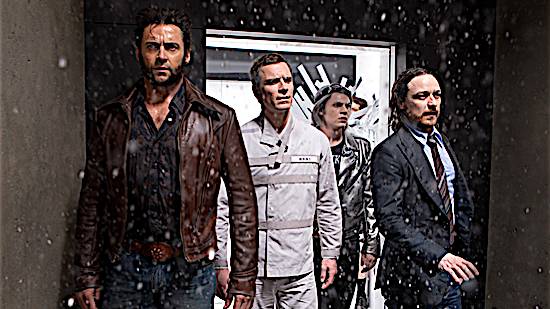
Bryan Singer’s ambitious blockbuster clears the deck of questionable dramatic (not to mention fan-enraging) choices made in the inferior efforts following X2: X-Men United. It also functions as compelling evidence that Singer’s DNA may just house a special mutant power of its own. And it’s needed—given the sheer volume of both character and plot, Days of Future Past could easily have proved an incomprehensible slog even for Marvel True Believers. Happily, much as with prior Singer-helmed X-Men films, the director seems to instinctively know exactly when to pull back on the exhilarating action set pieces, and push in on his absurdly over-qualified actors as they espouse the film’s central themes of second chances and choosing to tread the more difficult path of righteousness as opposed to self-righteousness. At 131 minutes, Days of Future Past is filled to near bursting as its enormous cast scrambles through the vagaries of its time travel paradox-rich design, and Singer threads the needle with such apparent effortlessness in stitching it all together, the seams are practically invisible. It may not be as showy as telekinesis or plasma-laser eyes, but his is an uncanny gift nevertheless. —Scott Wold
24. Minority Report (2002)
Director: Steven Spielberg

The more we become connected, the more any sense of personal privacy completely evaporates. So goes Steven Spielberg’s vision for our near future, couched in the signifiers of a neo-noir, mostly because the veil of safety and security has been—today, in 2002 and for decades to come—irrevocably ripped from our eyes. What we see (and everything we don’t) becomes the stuff of life and death in this shadowed thriller, based on a Philip K. Dick story, about a pre-crime cop John Anderton (Tom Cruise) whose loyalty and dedication to his job can’t save him from meaner bureaucratic forces. Screenwriters Scott Frank and Jon Cohen’s plot clicks faultlessly into place, buoyed by breathtaking action setpieces—metallic tracking spiders ticking and swarming across a decrepit apartment floor to find Anderton, the man submerged in an ice-cold bathtub with his eyes recently switched out via black market surgery, immediately lurches to mind—but most impressive is Spielberg’s sophistication, unafraid of the bleak tidings his film prophecies even as it feigns a storybook ending. —Dom Sinacola
23. Videodrome (1985)
Director: David Cronenberg
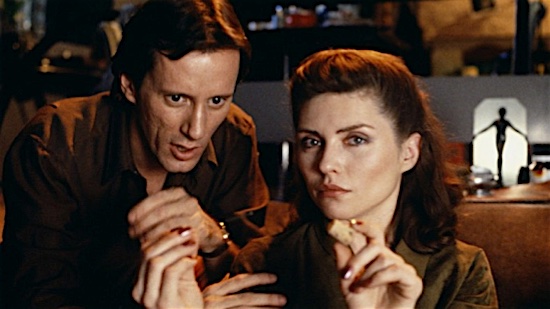
Videodrome wears many skins: It’s a near-future thriller about the lines between man and machine blurring, a sadomasochistic fantasy, a chronicle of one man’s tragic descent into madness and even a screed against society’s abusive relationship with theatrical violence. Yet, more than any dermis it claims as its own, Videodrome is horror down to its bones, a shard of phantasmagorical mania wielded by the genre’s most cerebral master. The mind is where Cronenberg creeps, taking his imagination’s darkest wanderings—steeped in symbolism and subconscious detritus—to visceral extremes. The same could be said for smut peddler Max Renn (the always sweaty James Woods), manager of a cable TV channel devoted to finding new boundary-breaking entertainment, who stumbles upon a pirated broadcast signal carrying “Videodrome,” a seemingly unsimulated series filled with graphic torture and death. As Cronenberg’s dark dreams tend to do, “Videodrome” begins to warp Renn’s reality—our mind’s eye, as one episode explains to him, is the television screen—and the malevolent forces behind “Videodrome” convince him to go on a killing spree, armed with his newly grown mutant cyborg hand (which might be a hallucination but probably isn’t). Throughout, Cronenberg literalizes Renn’s grossest thoughts, opening up a vaginal orifice in his stomach (into which he salaciously sticks his handgun) or transforming his television set into a pulsating, veined organ, manifesting each apocalyptic vision with immediate, tactile reality. In Videodrome, maybe more saliently than in any of his other films, Cronenberg squeezes the ordeals of the slumbering mind like toothpaste from the tube into the disgusting light of day, unable to push them back in. Long live the new flesh—because the old can no longer hold us together. —Dom Sinacola
22. Soylent Green (1973)
Director: Richard Fleischer

Cannibalism is usually such an intimate affair. Not so in Soylent Green, a loose adaptation of Harry Harrison’s 1966 novel, Make Room! Make Room!, in which “Soylent Green is people!” Along with his famous call for cleaner, less groping ape hands, Charlton Heston’s delivery of Soylent Green’s signature line has proven one of his most lasting contributions to pop culture, as well as one of the great spoilers of film history. —Michael Burgin
21. The LEGO Movie (2014)
Directors: Chris Miller, Phil Lord
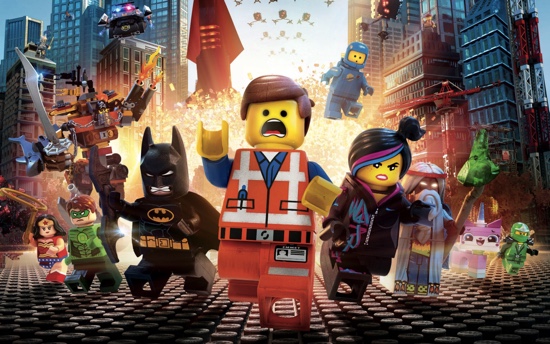
The LEGO Movie is a genuinely entertaining film from start to finish, so much so that it’s easy to forget the whole, “Oh, this is a pretty horrible dystopia, isn’t it?” It follows the life of a generic little guy, Emmet (voiced by Chris Pratt), as he goes about his happy daily life as a construction worker. Oblivious to the numbingly bland and forced conformity of his Lego society, Emmett cheerfully participates in this particular dystopia, following the rules to the letter until his simple ways are shaken to pieces when he is mistaken as “The Special,” a master-building savior of sorts who is prophesied to save the world. Though Emmet feels he has neither the talent nor the skill to really be “The Special,” he falls for a rebellious girl LEGO, Wyldstyle (Elizabeth Banks). From here, the movie riffs on the expected beats of the dystopic thriller in ways that are pretty joyful. If dark sci-fi is your bag, but you’d love your children not be scarred for life—or at least, rendered overly cynical at a young age—The LEGO Movie is a good place to go. —Maryann Koopman Kelly
20. The City of Lost Children (1998)
Directors: Jean-Pierre Jeunet, Marc Caro
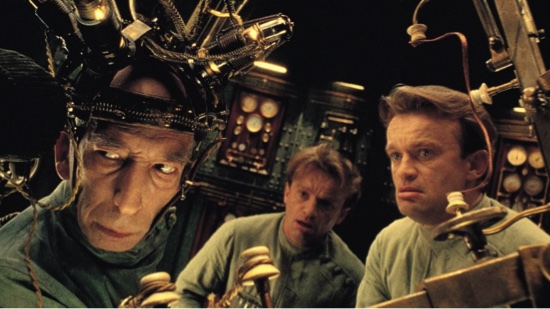
Ron Perlman plays the reluctant hero as a circus strongman named One looking for his adopted little brother Denree (Joseph Lucien), as Marc Caro (Delicatessen) and Jean-Pierre Jeunet (Amélie, also Delicatessen) team up to create a wildly imaginative dystopian universe. Krank (Daniel Emilfort), the evil creation of a mad scientist, is harvesting children’s dreams in order to keep himself young, so One must enlist the help of an orphaned street thief (Judith Vittet) to retrieve the kidnapped Denree. Populated with clones, Siamese twins, trained circus fleas and a Cyborg cult called the Cyclops, this steampunk fever dream has plenty for fans of Terry Gilliam and Michel Gondry. —Josh Jackson
19. Blade Runner 2049 (2017)
Director: Denis Villeneuve
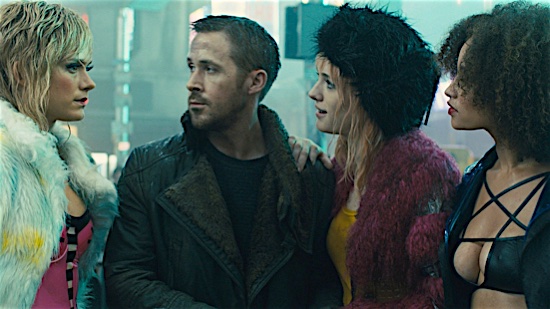
The debate between what makes something “real” or not has become a staple of adult-minded sci-fi fare in the three-plus decades since Ridley Scott made one genre masterpiece after another dithering over the same debate, but the strength of Blade Runner 2049 is in how intimately Villeneuve (and writers Hampton Fancher and Michael Green) attempt to have us experience this world through the unreal eyes of a Replicant, K (Ryan Gosling). Ideally, we’re forced to think about what “humanity” is when empathy—caring for these robots—is the natural result of the filmmakers’ storytelling. Revisiting Blade Runner, one may realize that there isn’t much of a story there. The same could be said for Dick’s novel, as well as many of his novels: There is breathtaking world-building, impressive use of language and speculative ideas expanded and thought out to thoroughly conceived ends, but our characters are just people existing in this world, and Blade Runner is really just the story of a cop hunting down four dangerous criminals. 2049, despite its heavy themes and heavier exposition, is about a cop who must find a very special robot before the evil mega-corporation does. The scale of the film is only matched by the constant dread of obscurity—illumination shifts endlessly, dust and smog both magnifying and drowning the sense-shattering corporate edifices and hyper-stylized rooms in which humanity retreats from the moribund natural world they’ve created. There is a massive world, a solar system, orbiting this wretched city—so overblown that San Diego is now a literal giant dump for New L.A.’s garbage—but so much of it lies in shadow and opacity, forever out of reach. What Scott and Cronenweth accomplished with the original film, placing a potboiler within a magnificently conceived alternative reality, Villeneuve and Deakins have respected as they prod at its boundaries. There’s no other way to describe what they’ve done other than to offer faint praise: They get it. —Dom Sinacola
18. Planet of the Apes (1968)
Director: Franklin J. Schaffner

“What will he find out there, doctor?” “His destiny” That’s what the conservative ape scientist Dr. Zaius (Maurice Evans) tells compassionate ape “veterinarian” Dr. Zira (Kim Hunter) at the end of the original Planet of the Apes, as misanthropic astronaut George Taylor (Charlton Heston) sets out into the Forbidden Zone of this topsy-turvy planet—where intelligent, talking apes are the dominant species and humans are dumb beasts—in order to find out what really happened to his species. Unless you were living under a rock for the last 50 years, you know exactly what he will find. But why does Zaius call this literally earth-shattering revelation Taylor’s destiny, and not his past, which is technically the case? The answer for that lies within Zaius’s role in the ape society. Unlike all other apes, Zaius knows the history of the painful and complex relationship between apes and humans. He knows how humans’ natural attraction to war, persecution, prejudice and cruelty sealed their eventual doom, and is (perhaps vainly) attempting to keep that “intellectual virus” from spreading to his beloved apes. He knows that once an intelligent human like Taylor has a chance to restart yet another attempt at civilization for his species, the same ugliness and destruction that comes with his inner nature will certainly plague his descendants. Therefore, he knows that Taylor will find both his past and his future on that beach. Today, the Planet of the Apes franchise is still going strong. The timeless appeal of these films stems from the fact that they explore high-concept themes, like the inherent viciousness and frailty of human nature, with brutal clarity, told with a refreshing lack of condescension and philosophical hand-holding. By presenting a fable world where what we now consider to be animals are dominating humankind, they hold a mirror to our ugliness, arrogance and, just maybe, our chance for redemption. Co-written by Twilight Zone co-creator Rod Serling, the sci-fi fable structure of the novel’s adaptation fits Serling’s sensibilities so impeccably that the original Planet of the Apes might be the closest we’ll ever get to a single-story, feature-length Twilight Zone movie, creating a kind of balanced synergy between pure genre excitement and level-headed morality tale. —Oktay Ege Kozak
17. World on a Wire (1973)
Director: Rainer Werner Fassbinder
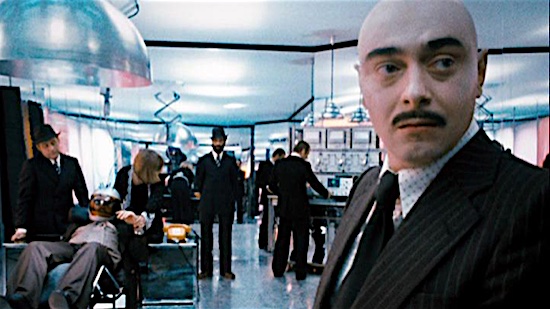
Those still banging the drum for The Matrix’s apparent “innovation” should reserve a four-hour slot for Rainer Werner Fassbinder’s ornate science-fiction drama World on a Wire, and discover that the idea of our world as a simulation (within a simulation, within a simulation …) had already been covered 26 years prior. Only recently revived as a “lost classic” of Fassbinder’s, it’s hard to imagine how forward-thinking World on a Wire must have appeared at the time, originally airing on German television in 1973. A technical director for a company that’s created a simulation of an entire world within its computers, Dr. Fred Stiller (Klaus Lowitch) investigates personally after his colleagues begin to disappear, and the people around him insist those now missing never actually existed at all. Framed beautifully among the mirrors and tacky futurist décor of early 1970s Germany, the film’s styled like the paranoid thrillers that were so popular at the time, only here the distrust grows epidemically—from initially incorporating Stiller’s associates, then the government, to eventually including Stiller’s fellow citizens and the very world he lives in. The fashion has aged; the ideas haven’t. —Brogan Morris
16. Seconds (1966)
Director: John Frankenheimer

Setting the tale from coast to coast in prosperous ’60s America, John Frankenheimer casts an eye through a thin veil of science fiction to what he sees as a failingly lonely way of life. Approached by a mysterious outfit known as “the Company,” middle-aged family man Arthur Hamilton (John Randolph) is given the opportunity to fake his death and start over as bohemian California-based painter Tony Wilson (Rock Hudson). Tapping away to the existential core, however, “Tony” only finds his new life as hollow as his old one, a construct populated by Company actors and other “reborns” who just want to sustain the illusion. James Wong Howe’s shadow-infused cinematography and Jerry Goldsmith’s anxious horror score apply the paranoid sheen to what is really a bleak examination of the contemporary domesticated worker—bleak because, minus the presence of the elusive, amoral Company, Seconds’ dystopian Earth is really our own. —Brogan Morris
15. Battle Royale (2000)
Directors: Kinji Fukasaku
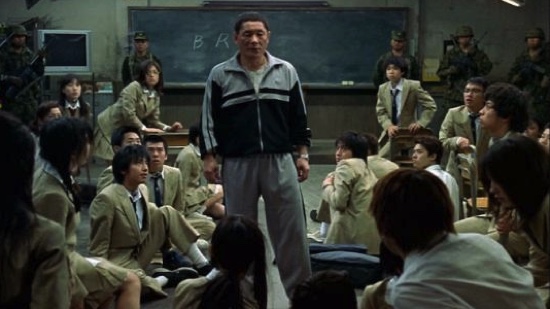
It’s OK to compare Battle Royale to The Hunger Games movies—or, rather, to find how the lasting accomplishments of the latter franchise were essentially done better and with so much more efficiency by the former—because you probably will anyway. Battle Royale, like the immensely successful four-film crash course in crafting an action star who is really only a symbol of an action star, chronicles a government-sanctioned battle to the death between a group of teens on a weird, weapon-strewn island. (There are even regular island-wide announcements of the day’s dead as the sun sets on the remaining children.) Yet, Battle Royale is so lean in its exposition, so uninterested in dragging out its symbolism or metaphor, that one can’t help but marvel at how cleanly Fukasaku (who had a full career behind him when he made this, only three years before he died) can lend depth to these children, building stakes around them to the point that their deaths matter and their doomed plights sting. What the director can do with such a tenuous premise (which The Hunger Games takes multiple films to do, and without a single ounce of levity) is astounding—plus, he wrangled Beat Takeshi Kitano to play the President Snow-type character, which Kitano does to near-perfection. That Battle Royale II sets out to up the stakes of the first film, especially given the first film’s crazy success in Japan, is to be expected, but stick to the first: Battle Royale will make you care about kids murdering each other more than you (probably) would anyway. —Dom Sinacola
14. 1984 (1984)
Director: Michael Radford

God only knows the depths of cliche one can mine from comparing the totalitarian fable 1984—and especially the book on which it’s based—to our current situation, our time. As we witness fascism rise at home and abroad, countless miseries playing out with such little notice all over the world, a book and its movie seem as facile as most of us feel, passive observers with no power to do much of anything. The hard-won beauty, then, of Michael Radford’s adaptation is how tactile it makes an allegorical world. Immediate and oppressively dusty, Roger Deakins’ cinematography weighs down all of George Orwell’s ideas about thought control and language manipulation and changing reality through changing history with the mundane consequences of an actual totalitarian society: complete and comprehensive decay. We follow Winston (John Hurt, empathetic skeleton and dystopian movie mainstay) as he goes about his quotidian, watching propaganda and smoking cigarettes and rewriting newspaper headlines at the State-sanctioned fake news headquarters and swigging gin and lusting after a fellow worker (Suzanna Hamilton) and hating that lust and journaling about it in a secret notebook he bought at a salvage shop in the outskirts of the urban center—a purposeless and gray life slipping into some sort of meaningless future. When the will of our protagonist’s broken, we endure that pain as well, understanding the threat of it in our guts. We are weak and fragile things, prone to breaking but filled with fear at the thought of it. Radford’s 1984, over 35 years later, keeps that fear alive in a way Orwell’s book never could. —Dom Sinacola
13. The Lobster (2015)
Director: Yorgos Lanthimos

Greek director Yorgos Lanthimos’s follow-up to international break-out Dogtooth ditches that film’s knotted familial pathology, but refuses to be any less insular. Instead, it expands, even bloats, Dogtooth’s logic as far as it’ll stretch. I know: That doesn’t make much sense, but stay with me—which is exactly how Lanthimos and co-writer Efthymis Filippou assume the audience will approach The Lobster, starting with the familiar, leading man visage of Colin Farrell, gone full dad-bod for a role that is debatably the actor’s best example for his still unheralded genius. With a remarkable dearth of charm, Farrell inhabits David, a man who, upon learning that his wife has cheated on him and so must end their relationship, is legally required to check in to a hotel where he has 45 days to find a new mate, lest he be transformed into an animal of his choosing. David easily settles upon the titular namesake, the lobster, which he explains he picks because of their seemingly-immortal lifespans, the creatures like human ears growing and growing without end until their supposed deaths. At the hotel, David tries his best to warm to a beautifully soul-less woman, knowing his remaining days are numbered, but the depths to which she subjects his resolve eventually encourages him to plan an escape, through which he matriculates into an off-the-grid conglomerate of single folk, led by Léa Seydoux. There, of course, against all rules he has a meet-cute with another outsider (Rachel Weisz) involving elaborately designed sign language (a metaphor maybe, like much in Lanthimos’s world, for the odd ritual of dating), and they fall in love. The world of The Lobster isn’t a dystopian future, more like a sort of mundane, suburban Everywhere in an allegorical alternate universe. Regardless, Lanthimos and Filippou find no pleasure in explaining the foundations of their film, busier building an absurdly funny edifice over which they can drape the tension and anxieties of modern romance. In that sense, The Lobster is an oddly feminist film, obsessed with time and how much pressure that puts on people, especially women, to root down and find someone, no matter the cost. If you’ve ever had a conversation with a significant other concerned about the increasing dangers of becoming pregnant in one’s late 30s, then The Lobster—and its ambiguous but no less arresting final shot—will strike uncomfortably close to the home you’re told you should have by now but probably can’t afford. —Dom Sinacola
12. Total Recall (1990)
Director: Paul Verhoeven
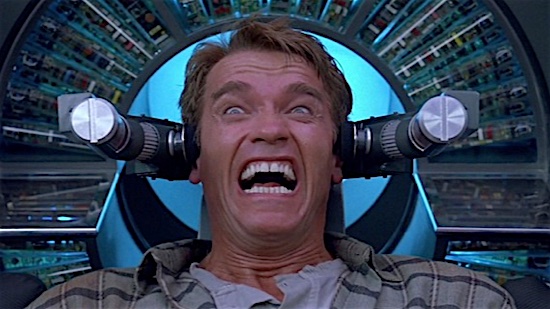
Very loosely based on the Philip K. Dick short story “We Can Remember It for You Wholesale” (and aren’t all PKD adaptations “very loose”?), Total Recall functions as a construct for Paul Verhoeven to take a high-concept premise about memory implants and lost identity and motivational uncertainty and turn it into an Arnold Schwarzenegger schlock-fest. It should be bad, but it’s not; it should be, at best, cheesy fun—but it’s even more than that. Unlike many of it’s sci-fi action peers, Total Recall never runs out of steam or ideas; it starts with the memory implant stuff, but on the back end gives us a vividly imagined Mars society with an oppressed mutant population (which is, like, the best special make-up effects portfolio ever) and a secret alien reactor that’s a MacGuffin but also a deus ex machina. The plot’s a mess but so is Arnold. It all works. Total Recall’s $60 million production budget was absolutely huge for its time, but unlike similar Hollywood ventures that put money towards glitz (like the 2012 remake, so slick it slips right out of one’s head), Verhoeven uses the loot to give us more dust, more grit, more decrepit sets, more twisted prosthetics and maximum Arnold. Verhoeven, in fact, uses Arnold as much as he uses anything else in the budget to tell this darkly exuberant story, from the contorted confusion of the set-up right on through to the eye-popping finale. It results in a sci-fi screed written in the form of a hundred Ahh-nuld faces, absurd and unforgettable. For as many times as Dick has been adapted, this is perhaps the one time the go-for-broke energy and imagination of his work has made it into the cinema (Blade Runner is something else entirely). Total Recall may have little in common with the actual content of the story it blows up, but it knows the vibe. And PKD vibes are the best kind. —Chad Betz
11. The Trial (1962)
Director: Orson Welles
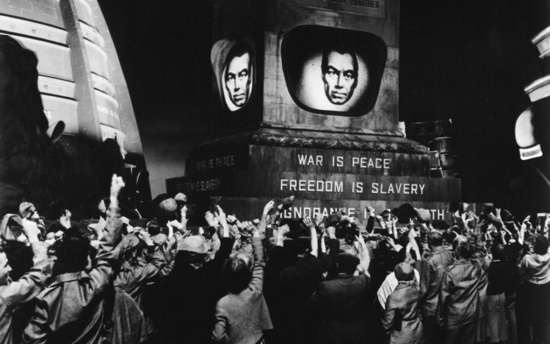
It’s difficult to classify Orson Welles’ The Trial; it’s certainly not of this world, instead seemingly the product of some muted parallel universe. A cynical blend of defeatist anti-thriller and jet-black comedy set in a sparse, loveless city draped in perpetual dusk, the film stars Anthony Perkins (despairingly comical) as Josef K, an office drone who’s put on trial without knowing the nature of his crime. Fluctuating between satire and full-on nightmare, The Trial is dense with ideas and themes for the viewer to wade through along with K, as he’s seduced by harpies and taunted by oddballs on his way to discovering there’s no straight answer to why he’s on trial, and that for a man to ask the question “Why?” in such a world is in itself a crime. The term “ahead of its time” is often applied to the films of Welles, and is more so as we reevaluate his body of work and realize there’s so much more to the other-than-Citizen Kanes in his back catalog. There’s a feeling, though, that The Trial will forever seem ahead of its time—it is nearly impenetrable more than 50 years later. It’s also absolutely unforgettable. —Brogan Morris
10. A Clockwork Orange (1971)
Director: Stanley Kubrick
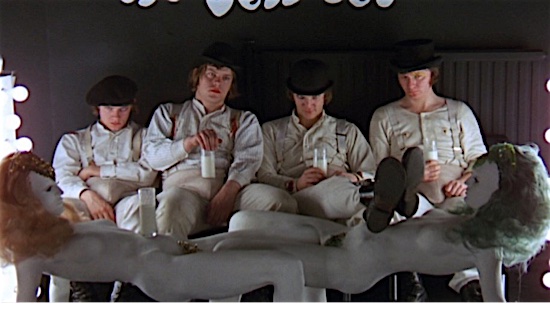
As with most (well, probably all) of Stanley Kubric’s book-to-screen adaptations, A Clockwork Orange remixes several aspects from Anthony Burgess’s novel, and probably for the better (at least Alex [a terrifyingly electric Malcolm McDowell] isn’t a pedophile in Kubrick’s film, for example). It’s still a relentlessly vicious satire portraying a society permissive of brutal youth culture, one where modern science and psychology are the best countermeasures in combating the Ultra Violence ™ that men like Alex and his fellow “droogs” commit. It’s painfully clear that when Alex is cast as a victim by the British Minister of the Interior (Anthony Sharp) that—spoiler alert!—evil wins. Christ, can any of us ever hear “Singing in the Rain” the same again after this nightmare? —Scott Wold
9. Children of Men (2006)
Director: Alfonso Cuarón
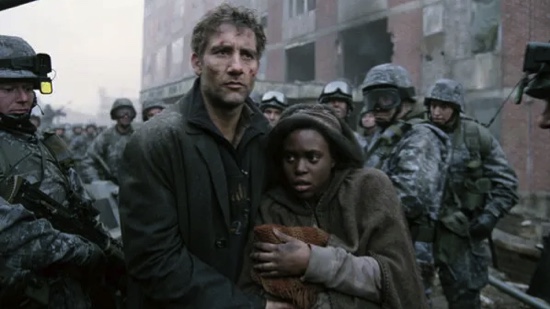
We remember the dread most—the sense of relentless, inevitable doom, from its literally explosive opening moments to its breathlessly ambiguous final seconds, the whole of Children of Men shot through with dismal grayscale, as if the human race were still coming to terms with its combustion though everyone waded through the ashes. In 2027, beleaguered former activist and current bureaucrat, Theo (Clive Owen), wanders amongst the increasing civil unrest fueled by British armed forces clamping down on refugees fleeing the rest of the world’s civilizational decline. Cynical and cornered by death at every turn, Theo can’t help but assist his estranged ex wife (Julianne Moore), taking on the protection of Kee (Clare Hope-Ashitey), a Virgin Mary figure and the last known pregnant woman on Earth. Theo’s odyssey takes him through the last vestiges of a broken world, director Alfonso Cuarón staging terrible spectacles—an assault on a car, a nightmarish refugee camp, a wartorn urban battlefield—often in long takes (or digitally edited to appear as long takes) and weighted with unbelievably visceral stakes. Yet, despite all of Cuarón’s technical bravura, what remains long after Children of Men’s ended is its refusal to resolve Theo’s journey, to ascribe to what he’s accomplished any hope, hopeful that there is still time, but hopeless that there’s anything left we can do. The apocalypse has never felt so immersive. —Dom Sinacola
8. Stalker (1979)
Director: Andrei Tarkovsky

“Once, the future was only a continuation of the present. All its changes loomed somewhere beyond the horizon. But now the future’s a part of the present.” So says the Writer (Anatoli Solonitsyn) in Andrei Tarkovsky’s Stalker, somewhere deep in the Zone, contemplating the deeper trenches of his subconscious, of his fears and life and whatever “filth” exists within him. “Are they prepared for this?” he asks. In Tarkovsky’s last Soviet film, the director seems to be admitting that what he’s feared most has come to pass.
What that means is of course nebulous for a viewer not steeped in the director’s life or in the history of the country that was both home and hostile to him and his work throughout most of his life. Based very loosely on Roadside Picnic, a novel by brothers Boris and Arkady Strugatsky (who also wrote the screenplay), Stalker imagines a dystopic future not far from our present—or Tarkovsky’s present, before the fall of the Berlin Wall or the devastation of Chernobyl—in which some sort of otherworldly force has deposited a place humans have called “the Zone” onto Earth. There, the laws of Nature don’t apply, time and space thwarted by the hidden desires and wills of all those who enter it.
Of course, the government has set up cordons around the Zone, and entry is strictly prohibited. Guides/liaisons called “stalkers” head illegal expeditions into the Zone, taking clients (often intellectual elites who can afford the trip) into the heart of the restricted, alien area—in search of, as we learn as the film slowly moves on, the so-called “Room,” where a person’s deepest desires become reality. One such Stalker (Aleksandr Kaidanovsky) is hired by the aforementioned Writer and a physicist (or something) known only as the Professor (Nikolai Grinko) to lead them into the Zone, spurred by vague ideas of what they’ll find when they reach the Room. The audience is as much in the dark, and through Tarkovsky’s (near-intolerably) patient shots, the three men come to discover, as do those watching their journey, what has really brought them to such an awful extreme as hiring a spiritual criminal to guide them into the almost certain doom of whatever the Zone has waiting for them.
And yet, no context properly prepares a viewer for the harrowing, hypnotic experience of watching Stalker. Between the sepia wasteland outside the Zone (so detailed in its grime and suspended misery you may need to take a shower afterwards) and the oversaturated greens and blues of the wreckage inside, Tarkovsky moves almost imperceptibly, taking the rhythms of industry and the empty lulls of post-industrial life to the point of making the barely mystical overwhelmingly manifest. Throughout that push and pull, there is the mounting sense of escape—of Tarkovsky escaping the Soviet Union and its restrictions on his films, maybe—as equally as there is the sense that escape should never be attempted. Some freedom, some knowledge, the director seems to say, isn’t meant for us. —Dom Sinacola
7. Akira (1988)
Director: Katsuhiro Otomo

The sum total of anime cinema from the early ’90s to present day is marked by the precedent of Katsuhiro Otomo’s Akira. Adapted from the early chapters of Otomo’s landmark manga series, Akira was the most expensive animated film of its time and a cinematic benchmark that sent shockwaves throughout the industry. Taking place 31 years after after World War III was sparked by a massive explosion that engulfed the city of Tokyo, Akira is set in the sprawling metropolis of Neo-Tokyo, built on the ruins of the former and teetering precariously on the cusp of social upheaval. The film follows the stories of Kaneda Shotaro and Tetsuo Shima, two members of a youth motorcycle gang whose lives are irrevocably changed one fateful night on the outskirts of the city. While clashing against a rival bike gang during a turf feud, Tetsuo crashes into a strange child and is promptly whisked away by a clandestine military outfit while Kaneda and his friends look on, helplessly. From then, Tetsuo begins to develop frightening new psychic abilities as Kaneda tries desperately to mount a rescue. Eventually the journeys of these two childhood friends will meet and clash in a spectacular series of showdowns encircling an ominous secret whose very origins rest at the dark heart of the city’s catastrophic past: a power known only as “Akira.” Like Ghost in the Shell that followed it, Akira is considered a touchstone of the cyberpunk genre, though its inspirations run much deeper than paying homage to William Gibson’s Neuromancer or Ridley Scott’s Blade Runner. Akira is a film whose origins and aesthetic are inextricably rooted in the history of post-war Japan, from the 1964 Tokyo Olympics and the “Anpo” student protests of that era to the country’s economic boom and the then-nascent counterculture of Bosozoku racing. Akira is a film of many messages, the least of which a coded anti-nuclear parable and a screed against wanton capitalism and the hubris of “progress.” But perhaps most poignantly, at its heart, it is the story of watching your best friend turn into a monster. Akira is almost single-handedly responsible for the early 1990s boom in anime in the West, its aesthetic vision rippling across every major art form, inspiring an entire generation of artists, filmmakers and even musicians in its wake. For these reasons and so many more, every anime fan must grapple at some point or another with Akira’s primacy as the most important anime film ever made. —Toussaint Egan
6. Metropolis (1927)
Director: Fritz Lang

Metropolis never slows as it delivers a constant stream of iconic images. Fritz Lang filled his parable with all the sci-fi/adventure tropes he could: the mad scientist, the robot, the rooftop chase, the catacombs and, as it turns out, a devious henchman. Metropolis, too, is a great reminder of just how difficult it is to judge an incomplete film. In fact, many silent films are missing material, even when it isn’t made clear in screenings or on home video. While Lang’s film has always been known for its spectacular special effects—it’s legally required that I use the phrase “visionary” while discussing it—not until a few years ago did modern audiences see a film anywhere close to the one that first premiered. It turned out that Metropolis’s best performance, Fritz Rasp as a ruthless spy for the corporate state, was part of that missing material, and it gives the film a greater sense of urgency, increasing the feeling of class-based antagonism. With that unknown excellence lurking in one of the most famous films of all time, it leaves us to wonder what else was lost in nitrate flames. —Jeremy Mathews
5. WALL-E (2008)
Director: Andrew Stanton
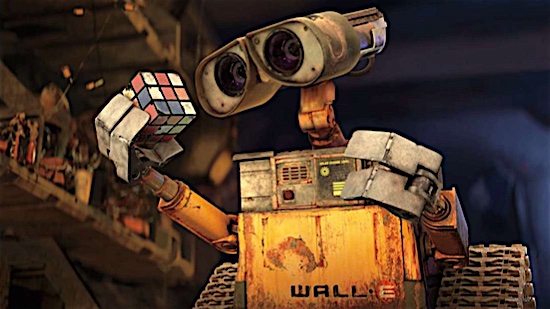
Opening with 45 sublime minutes of almost no dialogue, WALL-E was a significant gamble for Pixar, whose remarkable string of successes to that point fell within a pretty narrow range. WALL-E rests firmly in the realm of children’s fantasy, but writer-director Andrew Stanton shooed the celebrity voices away from the center of the film and was clearly reaching toward something new. In a post-post-apocalyptic world where humans have gone into space and left behind an army of machines to clean up the place, 700 years have passed without much progress, and even the machines have fallen into ruin, except for one, a dilapidated ottoman-sized trash compactor named WALL-E who’s still honoring his directive and pining for a lost world. When WALL-E meets a gleaming white probe named Eve, their tentative relationship, like the rest of the film, evolves with few words. Even as the setting shifts to the ship containing the aforementioned humans and the rhythm shifts to action sequences with hazy goals, he film’s promise reduced to a well-executed but ordinary need for adrenaline, WALL-E is a noble experiment, lingering in the mind long after movies like Cars have faded. —Robert Davis
4. Robocop (1987)
Director: Paul Verhoeven
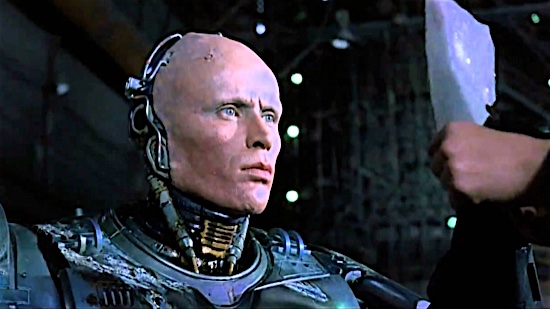
Throughout the late-1970s and indulgent ’80s, “industry” went pejorative and Corporate America bleached white all but the most functional of blue collars. Broadly speaking, of course: Manufacturing was booming, but the homegrown “Big Three” automobile companies in Detroit—facing astronomical gas prices via the growth of OPEC, as well as increasing foreign competition and the decentralization of their labor force—resorted to drastic cost-cutting measures, investing in automation (which of course put thousands of people out of work, closing a number of plants) and moving facilities to “low-wage” countries (further decimating all hope for a secure assembly line job in the area). The impact of such a massive tectonic shift in the very foundation of the auto industry pushed aftershocks felt, of course, throughout the Rust Belt and the Midwest—but for Detroit, whose essence seemed composed almost wholly of exhaust fumes, the change left the city in an ever-present state of decay. And so, though it was filmed in Pittsburgh and around Texas, Detroit is the only logical city for a Robocop to inhabit. A practically peerless, putrid, brash concoction of social consciousness, ultra-violence and existential curiosity, Paul Verhoeven’s first Hollywood feature made its tenor clear: A new industrial revolution must take place not within the ranks of the unions or inside board rooms, but within the self. By 1987, much of the city was already in complete disarray, the closing of Michigan Central Station—and the admission that Detroit was no longer a vital hub of commerce—barely a year away, but its role as poster child for the Downfall of Western Civilization had yet to gain any real traction. Verhoeven screamed this notion alive. He made Detroit’s decay tactile, visceral and immeasurably loud, limning it in ideas about the limits of human identity and the hilarity of consumer culture. As Verhoeven passed a Christ-like cyborg—a true melding of man and savior—through the crumbling post-apocalyptic fringes of a part of the world that once held so much prosperity and hope, he wasn’t pointing to the hellscape of future Detroit as the battlefield over which the working class will fight against the greedy 1%, but instead to the robot cop, to Murphy (Peter Weller), as the battlefield unto himself. How can any of us save a place like Detroit? In Robocop, it’s a deeply personal matter. —Dom Sinacola
3. The Matrix (1999)
Directors: The Wachowskis
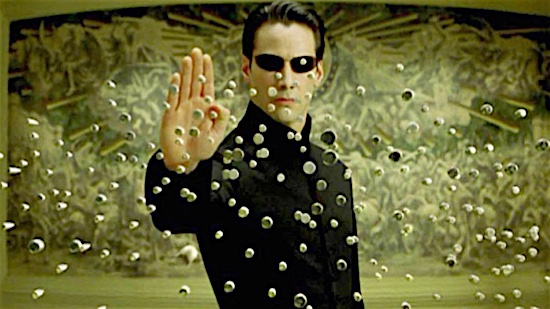
There is little to add about what’s been already codified about the film that made cyberpunk not stupid—and therefore is the best cyberpunk movie of all time, amidst its many accomplishments—or that made Keanu Reeves a respectable figure of American kung fu, or that finally made martial arts films a seriously hot commodity outside of Asia. The story of a computer hacker who woke up to the reality that everything he knows is an illusion constructed to placate humanity under the reign of a super-race of robot squids, The Matrix is—next to the Wu-Tang Clan—what proved to a new generation that martial arts films were worth their scrutiny, and in that reputation is bred college classes, heroes’ journeys and impossible expectations for special effects. Even today we still have this film to thank for so much of what we love about modern kinetic cinema, about how malleable genius science fiction can be, about just how deeply our connection to mythmaking—to the religiosity of civilization’s symbols—can reach. This is our red pill; everything else is an illusion of greatness and everything else is an allusion to what the Wachowskis accomplished, including the two sequels—bloated and beautiful and unlike anything anyone could have expected from the relatively self-contained original—which in turn earned the distinction of setting the course for every multi-part franchise to come —Dom Sinacola
2. Brazil
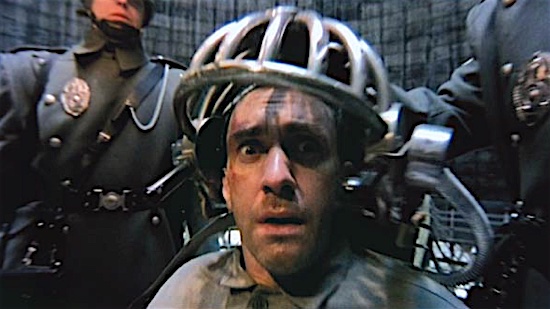
Taking place in a dystopic future a little goofier than the classic Orwellian version (though no less sinister), the world of Terry Gilliam’s 1985 film is the lovechild that results when bureaucratic nightmare meets escapist fantasy. The result is lyrical and beautiful, as well as horrific and haunting. Though decades of ill-fated and tumultuous productions lay ahead for the Monty Python alum, Brazil remains one of the purest and most palatable expressions of Gilliam’s unique vision. —Michael Burgin
1. Blade Runner (1982)
Director: Ridley Scott

Just as The Road Warrior set the look and tone for countless post-apocalyptic cinema-scapes to follow, so too did the world of Ridley Scott’s dingy, wet and overcrowded Blade Runner set the standard for the depiction of pre-apocalyptic dystopias. But he also had Harrison Ford, Sean Young, Rutger Hauer and a cast of actors who all bring this Philip K. Dick-inspired tale of a replicant-retiring policeman to gritty, believable life. Beneath the film’s impressive set design and inspired performances lies a compelling meditation on the lurking loneliness of the human (and, perhaps, inhuman) condition that continues to resonate (and trigger new creations, like Villeneuve’s Blade Runner 2049) to this day. —Michael Burgin